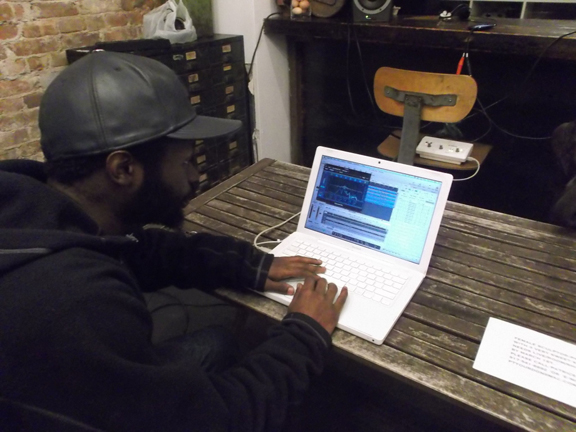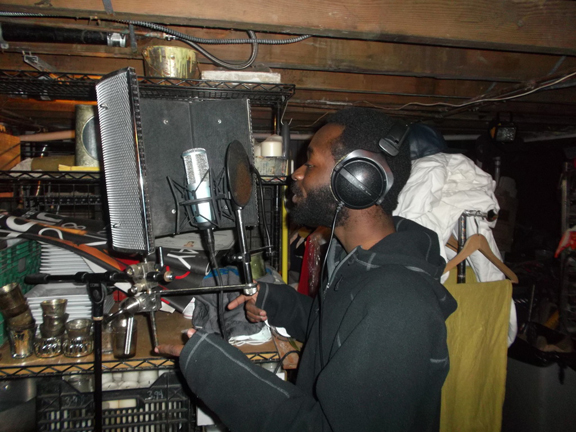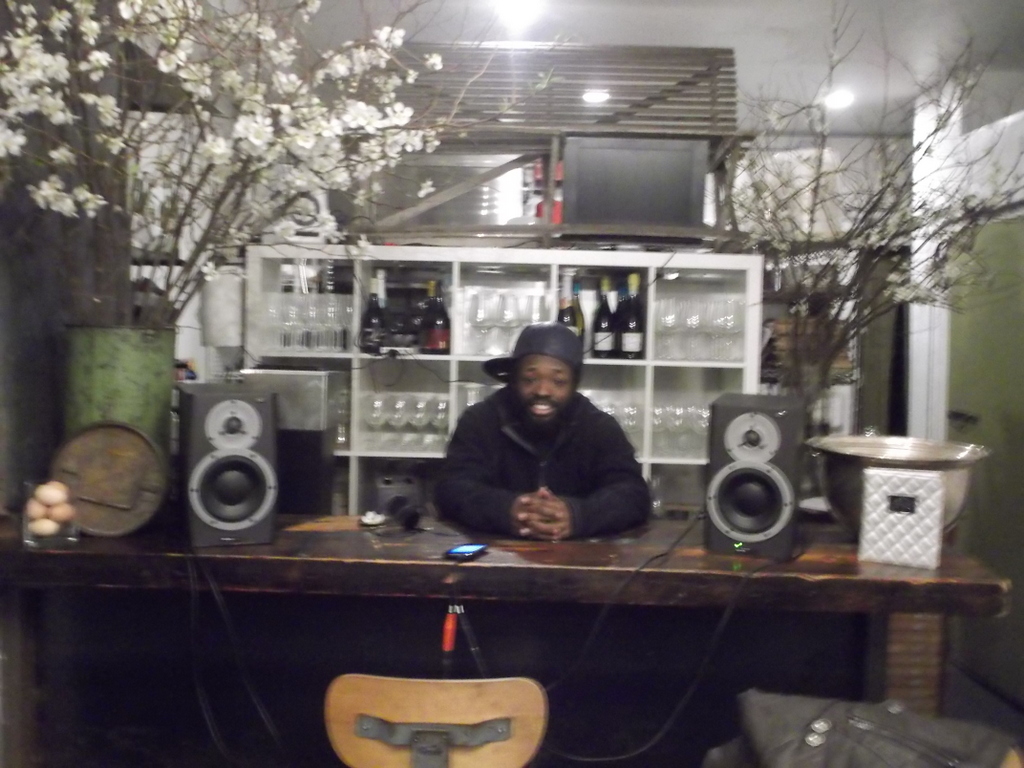
Tyquan Carter’s black sweatshirt shrugs as he clicks down the wooden steps. In the basement’s nadir, he walks past brass cups, a power sander and toilet paper. He pauses, then dusts a canvas bag from the top before he can reach it: his pile of recording equipment—each piece fought for, each piece won.
They include a Sony Handycam, a microphone, a filter screen for recording, a microphone stand, a midi keyboard, a full-HD Canon T2i, and an Mbox recording interface. Together with speakers and a laptop, they cost him over $1700, but he’s split the costs and distributed them over the past two years.
When he has what he needs, Tyquan mounts the steps back into the restaurant where his mother, Judy, helps clean up. It’s 7:30 pm, which is well after hours. He sets the equipment down. He nestles one large speaker against a green watering can at one end of the bar, and another against a chrome pot several feet further down. He tilts them so their vantages intersect with a third point: himself, seated at a wooden table and his laptop.
“This way, I get all the sounds coming into me. I mix them down, tighten the song’s beat and then add some sounds to fill it up,” he explains.
While he peers at his songs’ multitudinous layers and their assorted sound levels, Tyquan’s voice disappears from the conversation. From this angle, a green watering can sprouts above his head and white quince flowers bloom from spidery branches like synapses. For Tyquan—whose family’s home was destroyed by Hurricane Sandy—Van Brunt’s Home/made is a “good studio, even if it’s not really a studio” for his rapping, beat-producing and video-editing.
A Typology of Hooks
As Gary Burns noted in a 1987 Popular Music article, Delson’s Dictionary defines a “hook” as “that part of a song, sometimes the title or the key lyric line, that keeps recurring.” To songwriters Al Kasha and Joel Hirschhorn, hooks are “the foundation of commercial songwriting, particularly hit single-writing.” The latter writers also believed the best hooks contain one or more of the following: “(a) a driving, danceable rhythm; (b) a melody that stays in people’s minds; (c) a lyric that furthers the dramatic action, or defines a person or place.”
Tyquan—who performs under the name “Happy” or “Haps”—has lived in Red Hook his entire life. He went to PS 15 and PS 142. He angles his way across Columbia Street, against the waterfront and through the Red Hook Houses when he shoots footage for his documentaries and music videos. He records at Home/made and performs at the Ice House. He calls this place his “block,” and his “home”—and now, through his audio and video projects—and through the constant accumulation of new skills—the 22-year-old attempts to understand these places’ variegation.
Tyquan got his start in high school—at the Greenburgh Academy—when the raps he wrote with his cousin Benny Dorlisme netted an increasing amount of his classmates’ attention. In 2008, they wrote a song called “Business.” But it was Tyquan whom his classmates described as the school’s “best writer.” More of his raps solidified this title; and Tyquan’s name encrusted the title of a rap collective that appeared soon after.
When “Tyquan’s Finest” began, other members had problems with the name. Why Tyquan’s, they asked, and not their own? If it wasn’t mutiny, there was at least thwarted ambition in the air—until Tyquan quelled it with a simple explanation:
“If Jay-Z showed up to our sessions, we’d all be Jay-Z’s Finest. But right now, I’m the one with the name,” he told them.
If his tack seemed Machiavellian, they were soon convinced otherwise. The work ethic surrounding Tyquan with his music—and the support he banded together for others—made it clear that he was interested in the success of not just the group he helmed, but each of its members as individuals. He just happened to be the most swashbuckling of the Musketeers.
At ages 17, 18 and 19, he went online and into the streets promoting his group. Songs like “Flyin’ over airplanes” and “Can you get me one?” were firmly tongue-in-cheek, and went cheek by jowl with one of Tyquan’s teachers’ assertions that what he wrote was “fantasy.” Themes of money and women—the usual suspects in rap lyrics—really only worked because Tyquan’s lyrics held water and he knew how to use his voice.
It’s a memorable voice—tense and tinny in a way that carries—capable of producing the type of compact melody required by the “hook.” But as Tyquan later found out, the rappers who only know how to rap don’t have many legs on which to stand. Rapping, he realized, had to go hand-in-hand with video-editing, beat-making and other audio-engineering techniques.
Blotted Stars
According to Kasha and Hirschhorn, the “hook” is also “what you’re selling.” Tyquan, who began rapping and making music for fun, was now realizing that everything about the process has a cost.
He looked at his friends who’d signed with labels—some of them major ones—but were still getting pennies to the dollars they’d imagined earning. He reconsidered adages about record companies, where the rapper is the person who makes the least amount of money in a given company—because he’s merely an input, or a cog in a well-oiled machine. He looked up the numbers and saw how producers split off half the earnings for their work with a rapper’s lyrics. He found out that radio plays net a singer copper Lincolns, and not green Washingtons.

Tyquan did not want to be pigeonholed. So parallel to his time finishing at the Greenburgh Academy—and parallel to the time he promoted Tyquan’s Finest—he turned up for an after-school internship editing videos at CityPark Productions in the Red Hook Community Center.
At the onset, he remained unimpressed by video editing. He spent his time at the beat-making station that filled out the back end of the same room at the center. He planked out beats using a program called Reason. With a good microphone in hand, Tyquan recorded his voice with another program, Audacity. Competition among the students was his teacher. Benny was one.
Something slipped. Tyquan faltered with the technologies. When he listened to Benny’s music, the difference was clear.
“Why you better than me?” he couldn’t help asking.
If he confided his admiration for Benny’s music with him, he silently bristled at the criticism other interns spiked toward his music.
“Your songs are corny,” they taunted.
The challenge drove Tyquan harder. He developed his skills with Reason and Audacity and became harder to ignore both in the studio and at his high school.
Tyquan’s house was in Red Hook, but the Greenburgh Academy was in Yonkers. So each morning, Tyquan threw the covers off at a crisp 5:30 in the morning. He needed to leave by 6 am to make it to school at 8 am.
He would walk from 417 Van Brunt to the Smith and 9th Street station for the F-train. From Jay Street-MetroTech, he took the A-train to 59th Street; from there, the 1-train all the way to 242nd Street for the 1-bus. And from there it was still a 40-minute-drive to Yonkers. Tyquan listened to music and crafted beats and songs in his head for the whole ride.
He did the same on the ride home after leaving school promptly after the bell rang at 2:15 pm. On Tuesdays, Wednesdays and Thursdays he needed to make it back to CityPark Productions to enjoy what studio time he could before it closed at 8 pm. Often, the time was not enough for Tyquan. So he worked Saturdays in the studio.
As his beat-making skills gained new dimensions, new barriers appeared on the horizon. At the presentation of the interns’ first projects, he sat entranced by a well-synced video shot and arranged by someone who was also a fine rapper. When his own video came on, his rap skill seemed to him entirely negated out by his half-baked video—a project he’d let another student take the lead on.
The assertions that his work was “corny” wouldn’t go away. At the same time, he knew that if he didn’t develop his skills to the length that this other rapper and video producer had, he could only hope to be chaff with record studios—a blotted star who’d be bound to ink a lemon of a contract.
The Fruits of Reason
According to the songwriter Arnold Shaw, a “hook” is “an appealing musical sequence or phrase, a bit of harmony or sound, or a rhythmic figure that grabs or hooks a listener…a bit of music or words so compelling that it worms its way into one’s memory and won’t go away.”
In his mind, Tyquan slashed out a plan for his next video. Instead of delegating the task to another student, and instead of relying on the prodding of a teacher who seemed at times uninspired—or at least unable to attend to each student’s project—he would place the brunt of the new work squarely on his own shoulders.
It was not as simple as he’d hoped. The work of shooting scenes and framing them with fewer lights than was adequate with a green screen was grating. When he edited, he had to learn the use of even more software—this time, Final Cut Pro. He had to chop up scenes, erase ones he cherished and stack their blocks in a flashy way.
He forced deadlines out of his mind as he disappeared into this new virtual plane. New errors caused him delay after delay and it was over two months before the project was ready. He agonized because he “only” had two hours after school each day to work on it.
The new video for “Can you get me one?” was worth the wait. As Tyquan puts it, it “showed growth.” Looking back at it now, he sees flecks and blemishes he dislikes—a lightning-like green stripe across the breast of his shirt flickered uneasily with the green screen behind the video—but the video showcases new ease with video technology, his evolving sound, and his glib clothes.
Clothes and appearances, in general, are critical because they convey a rapper’s image. They’re part of “what you’re selling,” and Tyrone takes that fact just as seriously. In his videos, he sports jerseys, jackets, large watches and the ball caps that are metonyms for thug life, new money and gangster youth. The question “Can you get me one?” riffs on the materialism of girls dazzled by that wealth. In that video, Tyquan is wearing a large red cap with block letters spelling “ROOKIE” across the front.

Seated in his makeshift studio in Home/made, Tyquan is wearing a hat of similar style, but worked with comfortable black leather. The Yankees’ logo is stitched in the front. He says it’s part of the manufacturer’s “New Era” series.
If Tyquan styles his clothes to match rap’s message, he also learned to hone that message by working as a salesman. For three years, while he continued his apprenticeship at CityPark Productions, he hawked IKEA’s sales floors for $8.77 an hour.
“People would come up to me asking for the manager, and I would tell them—‘What do you need to talk to the manager for? Maybe I can solve your problem and help you right here, right now,’” he explains, pointing at the ground as he does so—presumably at a thrown gauntlet.
Gathering Storm
Gary Burns also discusses that the very word “hook” connotes being caught or trapped, as a fish skewered through its gills—or an addict hooked on a drug. Combined with repetition, you can make a “catchphrase” or “melody line.”
About a year ago, Tyquan began a private internship with CityPark Productions. Under the tutelage of the studio’s head engineer, he’s pored through texts devoted to audio mixing and mastering and figured out to space the tense mid-range frequencies of his voice from lower frequency beats and higher frequency melodies. His sound was becoming clearer, even if his themes continue to dwell on girls, money and his skills.
But for the head engineer, the progress couldn’t come quick enough. His vitriol for Tyquan’s work literally “scared” him, but also spurred him to quick improvement. In the same period that Tyquan spun reams of engineering information into his head, he also managed to record in partial form a large quantity of songs. His song bank now rolls about 150 which he hopes to eventually release.
But like all things in their course, Tyquan’s focus inward—his fixation on consolidating skills within himself in order to get the best record deal possible—was due for a correction. When Hurricane Sandy struck, his family’s home at 417 Van Brunt Street was eviscerated. The rubble of raw need lay bare.
Against the grain of hurricane damage, Tyquan was struck not just by statistics, but by the amount of individual tragedies lining his home streets. “Everybody has unique dreams,” as he put it, of “birthdays” and “holidays” with their families. After Sandy, those dreams awoke to fresh obstacles.
His own family had to trash all of their possessions, which were ruined by the storm. Much of their house had to be demolished; rafters and girders ripped out to the curb like refuse. Although they did receive grant money for repairs, the estimated time for renovation was about six months.
Tyquan, his mother, his nieces and the rest of his family struggled. But in the rubble Tyquan also saw music—and saw stories.
As part of his internship with CityPark Productions, he bent his footsteps back into the community to compile footage for a documentary. On the shoulders of their stories, on the strength of his mentors’ instruction, and on the weight of his own sadness, he arranged the copy for not just the documentary, but a song.
After Hours
In Home/made these nights, he’s back to Final Cut Pro. He wants to make video and audio that are flawless, even if his skills remain rough. His imperative is not just to enrich himself, but to add to the dialogue of the community post-Sandy.
And so he sits, cutting up accounts of life after life, mixing them in the order that makes sense. Shooting against a Red Hook instead of a green screen, certain errors resolve themselves: community activist Reg Flowers makes an impassioned appearance in a green sweater.
I met Tyquan at a dinner celebrating the immense effort the community made when it consolidated upon itself in the wake of Sandy. He performed a rough demo of his thus-inspired song. It’s clear to me that Tyquan’s star has yet to rise. There are still three and a half months until his house on 417 Van Brunt Street is revived. But there are ways in which the allure of his story is impossible to resist. As he puts it in the first line of the song—and the first line to strike him while walking his streets after the hurricane damage:
“You can spend your whole life listening to old news / I’m a man walking in my own shoes.”
Walking in white sneakers, a black Yankees hat and a brown leather jacket with buttons embossed with a Phoenix emblem—“Haps.”








